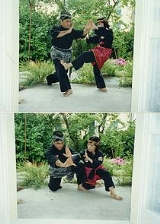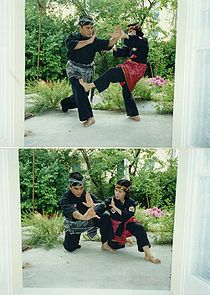
Seni Gayung Fatani
Encyclopedia
Seni Gayung Fatani is a style of silat
from northern Malaysia. Because of its artistic appearance, it is often mistaken for a dance. The steps and hand movements all have combat applications and are meant to lock or disable the opponent. The current grandmaster is Tuan Haji Anuar from the Pertubuhan Seni Gayung Fatani Malaysia (PSGFM).
In Malay
, the word seni means art and gayung or gayong is a word for martial arts synonymous with silat
. Fatani means wise in Arabic and was chosen because of its similarity to Patani, the kingdom from where the art originated.
, a state of southern Thailand
. It was first brought to Kedah
, Malaysia in 1840 by Syeikh Abdul Rahman. The style was expanded upon by his son Tok Yah Ramli. Another student from Syeikh Abd. Rahman was Pak Teh Mat Ali who taught this style to Pak Andak Embong. When it was registered in 1976 as an association under the Government's Club Act, the name was formalized to Seni Gayung Fatani.
Bunga Sembah http://www.youtube.com/watch?v=HBmVr7pll8w
Buah Pukulan
Tapak Empat
Jurus Olahraga http://www.youtube.com/watch?v=ZxVWjfz2Ew8
Silat Pulut
Silat
Silat Melayu is a blanket term for the types of silat created in peninsular Southeast Asia, particularly Malaysia, Thailand, Brunei and Singapore. The silat tradition has deep roots in Malay culture and can trace its origin to the dawn of Malay civilization, 2000 years ago...
from northern Malaysia. Because of its artistic appearance, it is often mistaken for a dance. The steps and hand movements all have combat applications and are meant to lock or disable the opponent. The current grandmaster is Tuan Haji Anuar from the Pertubuhan Seni Gayung Fatani Malaysia (PSGFM).
In Malay
Malay language
Malay is a major language of the Austronesian family. It is the official language of Malaysia , Indonesia , Brunei and Singapore...
, the word seni means art and gayung or gayong is a word for martial arts synonymous with silat
Silat
Silat Melayu is a blanket term for the types of silat created in peninsular Southeast Asia, particularly Malaysia, Thailand, Brunei and Singapore. The silat tradition has deep roots in Malay culture and can trace its origin to the dawn of Malay civilization, 2000 years ago...
. Fatani means wise in Arabic and was chosen because of its similarity to Patani, the kingdom from where the art originated.
Origin
Seni Gayung Fatani originated in PattaniPattani
Pattani may refer to* Pattani Province, in southern Thailand* Pattani , in southern Thailand* Pattani , which includes the above province** Pattani Kingdom, a former semi-independent kingdom...
, a state of southern Thailand
Thailand
Thailand , officially the Kingdom of Thailand , formerly known as Siam , is a country located at the centre of the Indochina peninsula and Southeast Asia. It is bordered to the north by Burma and Laos, to the east by Laos and Cambodia, to the south by the Gulf of Thailand and Malaysia, and to the...
. It was first brought to Kedah
Kedah
Kedah is a state of Malaysia, located in the northwestern part of Peninsular Malaysia. The state covers a total area of over 9,000 km², and it consists of the mainland and Langkawi. The mainland has a relatively flat terrain, which is used to grow rice...
, Malaysia in 1840 by Syeikh Abdul Rahman. The style was expanded upon by his son Tok Yah Ramli. Another student from Syeikh Abd. Rahman was Pak Teh Mat Ali who taught this style to Pak Andak Embong. When it was registered in 1976 as an association under the Government's Club Act, the name was formalized to Seni Gayung Fatani.
Syllabus
The new syllabus outlined by Tuan Haji Anuar has five different levels. Each level teaches techniques of its own while maintaining the same basic form. Some of these are:Bunga Sembah http://www.youtube.com/watch?v=HBmVr7pll8w
- A set of 16 steps intentionally designed to look flowery.
Buah Pukulan
- Combat sets meant to teach the application of techniques.

Tapak Empat
- In the tapak empat, the steps of the bunga sembah are performed in a square. It is meant to teach fluidity of movement whilst the silat pulut performed at the end is meant for the exponent to apply the techniques learnt.
Jurus Olahraga http://www.youtube.com/watch?v=ZxVWjfz2Ew8
- The offensive from of the bunga sembah in which the steps are either blocks, attacks or deflections.
Silat Pulut
- Silat pulut is the slow, technique-infused version of combat played out between two opponents. It is meant for the exponent to display their adeptness in silat by using techniques. The individuals who are playing it out also gain insight on how their moves can be deflected or used against them in combat.
Level 1
- This is the beginner level. The practitioner wears a white belt and is called anak gelanggang (child of the arena). This terms derives its meaning from the fact that at this level, the exponent would spend a lot of time in the gelanggang or training ground doing whatever the teacher asks.
- Bunga Sembah (level 1)
- Buah Pukulan (level 1, avoidance)
- Tapak Empat
- Jurus Olahraga (level 1)
- Technique: Avoidance
Level 2
- At this level, the practitioner wears a blue belt and is called pesilat muda or young silat exponent because they now have some knowledge of silat but not yet enough to qualify as a full-fledged trainee.
- Bunga Sembah (level 2)
- Buah Pukulan (level 2, avoidance and repelling attack)
- Tapak Empat
- Jurus Olahraga (level 2)
- Technique: Avoidance and repelling attacks
Level 3
- The practitioner now wears a green belt and is called a pesilat or silat exponent because they have now experienced enough to be able to apply techniques in combat.
- Bunga Sembah (level 3)
- Tapak Empat
- Jurus Olahraga
- Buah Pukulan is replaced by Tekong where the exponent is attacked by multiple assailants (weaponless attack) from different directions
- Technique: Avoidance, blocks, tangkapan (trapping or seizing) and felling an opponent
Level 4
- At this stage, the pesilat wears a red belt and is called a pendekar muda or young warrior. Now adept at applying techniques, the exponent can face off any attack by any assailant and is qualified to teach. Before being recognized as a pendekarPendekarPendekar or pandikar is a Malay word used to refer to or address masters of the martial arts, particularly silat. Not all masters carry the honorary title; it must be either officially bestowed by royalty or unofficially by commonfolk. The latter is most common today, especially outside Southeast...
, the pendekar muda may receive a black stripe on their bengkung (waist sash) for each year they show active participation and constant improvement.
- Bunga Sembah (level 4)
- Buah Pukulan (level 4, avoidance, repelling, tangkapan and locking the opponent)
- Tapak Empat
- Techniques: Avoidance, blocks, tangkapan, locks and armed combat (parang, krisKrisThe kris or keris is an asymmetrical dagger or sword nowadays most strongly associated with the culture of Indonesia, but also indigenous to Malaysia, Southern Thailand and Brunei. It is known as kalis in the southern Philippines. The kris is famous for its distinctive wavy blade , but many have...
, etc.)
Level 5
- The individual is a full-fledged warrior and is given the title PendekarPendekarPendekar or pandikar is a Malay word used to refer to or address masters of the martial arts, particularly silat. Not all masters carry the honorary title; it must be either officially bestowed by royalty or unofficially by commonfolk. The latter is most common today, especially outside Southeast...
. This level is not easily attained as the grading is only held when a pendekar muda is deemed fit for it. In becoming a pendekar, the exponent has to create their own bunga sembah, jurus olahraga and tapak empat which must not be similar to that of others. During grading, they will have to face off armed attacks by multiple assailants from different directions to qualify. - Techniques: Locking opponents and escaping locks; killing/disabling opponent, weaponry
External links
- Perguruan Seni Gayung Fatani Malaysia Official Website (Seni Gayung Fatani)
- Silat Official website (Silat Coaching Program)
- Pusat Cemerlang Silat official website (English)
- Seni gayung Fatani France
- Gayung Fatani Austria website
- Blog Rasmi Silat Melayu

